Assessing Machine Learning versus a Mathematical Model to Estimate the Transverse Shear Stress Distribution in a Rectangular Channel
Abstract
1. Introduction
2. Materials and Methods
2.1. Data Collection
2.2. Tsallis Entropy
2.3. Genetic Programming (GP)
2.4. Adaptive Neuro Fuzzy Inference System (ANFIS)
2.5. Criteria for Statistical Assessment
3. Results
3.1. Modeling of GP
3.2. ANFIS Modeling
3.3. Comparison of the GP Model, Tsallis Entropy and ANFIS
4. Conclusions
- The effect of different input variable on the result was investigated to find the best input combination.
- In the present study B/H had the highest effect on the prediction power.
- For bed shear stress predictions, the GP model, with an average RMSE of 0.0893 performed better than the Tsallis entropy-based equation and ANFIS model with RMSE of 0.0714 and 0.138 respectively.
- To estimate the wall shear stress distribution the proposed ANFIS model, with an average RMSE of 0.0846 outperformed the Tsallis entropy-based equation with an RMSE of 0.0880 followed by the GP model with an RMSE of 0.0904.
Author Contributions
Funding
Institutional Review Board Statement
Informed Consent Statement
Data Availability Statement
Conflicts of Interest
References
- Knight, D.W. Boundary shear in smooth and rough channels. J. Hydraul. Div. 1981, 107, 839–851. [Google Scholar] [CrossRef]
- Tominaga, A.; Nezu, I.; Ezaki, K.; Nakagawa, H. Three-dimensional turbulent structure in straight open channel flows. J. Hydraul. Res. 1989, 27, 149–173. [Google Scholar] [CrossRef]
- Seckin, G.; Seckin, N.; Yurtal, R. Boundary shear stress analysis in smooth rectangular channels. Can. J. Civ. Eng. 2006, 33, 336–342. [Google Scholar] [CrossRef]
- Khodashenas, S.R.; Paquier, A. A geometrical method for computing the distribution of boundary shear stress across irregular straight open channels. J. Hydraul. Res. 1999, 37, 381–388. [Google Scholar] [CrossRef]
- Pope, N.D.; Widdows, J.; Brinsley, M.D. Estimation of bed shear stress using the turbulent kinetic energy approach-A comparison of annular flume and field data. Cont. Shelf Res. 2006, 26, 959–970. [Google Scholar] [CrossRef]
- Knight, D.W.; Sterling, M. Boundary shear in circular pipes running partially full. J. Hydraul. Eng. 2000, 126, 263–275. [Google Scholar] [CrossRef]
- Park, J.H.; Do Kim, Y.; Park, Y.S.; Jo, J.A.; Kang, K. Direct measurement of bottom shear stress under high-velocity flow conditions. Flow Meas. Instrum. 2016, 50, 121–127. [Google Scholar] [CrossRef]
- Lashkar-Ara, B.; Fatahi, M. On the measurement of transverse shear stress in a rectangular open channel using an optimal Preston tube. Sci. Iran. 2020, 27, 57–67. [Google Scholar] [CrossRef]
- Berlamont, J.E.; Trouw, K.; Luyckx, G. Shear Stress Distribution in Partially Filled Pipes. J. Hydraul. Eng. 2003, 129, 697–705. [Google Scholar] [CrossRef]
- Sheikh Khozani, Z.; Wan Mohtar, W.H.M. Investigation of New Tsallis-Based Equation to Predict Shear Stress Distribution in Circular and Trapezoidal Channels. Entropy 2019, 21, 1046. [Google Scholar] [CrossRef]
- De Cacqueray, N.; Hargreaves, D.M.; Morvan, H.P. A computational study of shear stress in smooth rectangular channels. J. Hydraul. Res. 2009, 47, 50–57. [Google Scholar] [CrossRef]
- Yang, J.Q.; Kerger, F.; Nepf, H.M. Estimation of the bed shear stress in vegetated and bare channels with smooth beds. Water Resour. Res. 2015, 51, 3647–3663. [Google Scholar] [CrossRef]
- Martinez-Vazquez, P.; Sharifi, S. Modelling boundary shear stress distribution in open channels using a face recognition technique. J. Hydroinform. 2017, 19, 157–172. [Google Scholar] [CrossRef]
- Sterling, M.; Knight, D. An attempt at using the entropy approach to predict the transverse distribution of boundary shear stress in open channel flow. Stoch. Environ. Res. Risk Assess. 2002, 16, 127–142. [Google Scholar] [CrossRef]
- Sheikh Khozani, Z.; Bonakdari, H. Formulating the shear stress distribution in circular open channels based on the Renyi entropy. Phys. A Stat. Mech. Its Appl. 2018, 490, 114–126. [Google Scholar] [CrossRef]
- Sheikh Khozani, Z.; Bonakdari, H. A comparison of five different models in predicting the shear stress distribution in straight compound channels. Sci. Iran. Trans. A Civ. Eng. 2016, 23, 2536–2545. [Google Scholar] [CrossRef][Green Version]
- Sheikh Khozani, Z.; Hosseinjanzadeh, H.; Wan Mohtar, W.H.M. Shear force estimation in rough boundaries using SVR method. Appl. Water Sci. 2019. [Google Scholar] [CrossRef]
- Ardiçlioǧlu, M.; Sekçin, G.; Yurtal, R. Shear stress distributions along the cross section in smooth and rough open channel flows. Kuwait J. Sci. Eng. 2006, 33, 155–168. [Google Scholar]
- Bonakdari, H.; Tooshmalani, M.; Sheikh, Z. Predicting shear stress distribution in rectangular channels using entropy concept. Int. J. Eng. Trans. A Basics 2015, 28, 360–367. [Google Scholar] [CrossRef]
- Rankin, K.L.; Hires, R.I. Laboratory measurement of bottom shear stress on a movable bed. J. Geophys. Res. Ocean. 2000, 105, 17011–17019. [Google Scholar] [CrossRef]
- Kisi, O.; Dailr, A.H.; Cimen, M.; Shiri, J. Suspended sediment modeling using genetic programming and soft computing techniques. J. Hydrol. 2012, 450–451, 48–58. [Google Scholar] [CrossRef]
- Sheikh Khozani, Z.; Bonakdari, H.; Ebtehaj, I. An analysis of shear stress distribution in circular channels with sediment deposition based on Gene Expression Programming. Int. J. Sediment Res. 2017, 32, 575–584. [Google Scholar] [CrossRef]
- Sheikh Khozani, Z.; Bonakdari, H.; Zaji, A.H. Estimating the shear stress distribution in circular channels based on the randomized neural network technique. Appl. Soft Comput. 2017, 58, 441–448. [Google Scholar] [CrossRef]
- Tsallis, C. Possible generalization of Boltzmann-Gibbs statistics. J. Stat. Phys. 1988, 52, 479–487. [Google Scholar] [CrossRef]
- Jaynes, E.T. Information theory and statistical mechanics. II. Phys. Rev. 1957, 106, 620. [Google Scholar] [CrossRef]
- Singh, V.P.; Luo, H. Entropy Theory for Distribution of One-Dimensional Velocity in Open Channels. J. Hydrol. Eng. 2011, 16, 725–735. [Google Scholar] [CrossRef]
- Jayawardena, A.W.; Muttil, N.; Fernando, T.M.K.G. Rainfall-runoff modelling using genetic programming. In Proceedings of the International Congress on Modelling and Simulation: Advances and Applications for Management and Decision Making, Melbourne, Australia, 12–15 December 2005; pp. 1841–1847. [Google Scholar]
- Fatahi, M.; Lashkar-Ara, B. Estimating scour below inverted siphon structures using stochastic and soft computing approaches. J. AI Data Min. 2019, 5, 55–66. [Google Scholar]
- Jang, J.S.R. ANFIS: Adaptive-Network-Based Fuzzy Inference System. IEEE Trans. Syst. Man Cybern. 1993, 23, 665–685. [Google Scholar] [CrossRef]
- Willmott, C.J.; Matsuura, K. Advantages of the mean absolute error (MAE) over the root mean square error (RMSE) in assessing average model performance. Clim. Res. 2005, 30, 79–82. [Google Scholar] [CrossRef]
- McCuen, R.H.; Knight, Z.; Cutter, A.G. Evaluation of the Nash–Sutcliffe efficiency index. J. Hydrol. Eng. 2006, 11, 597–602. [Google Scholar] [CrossRef]
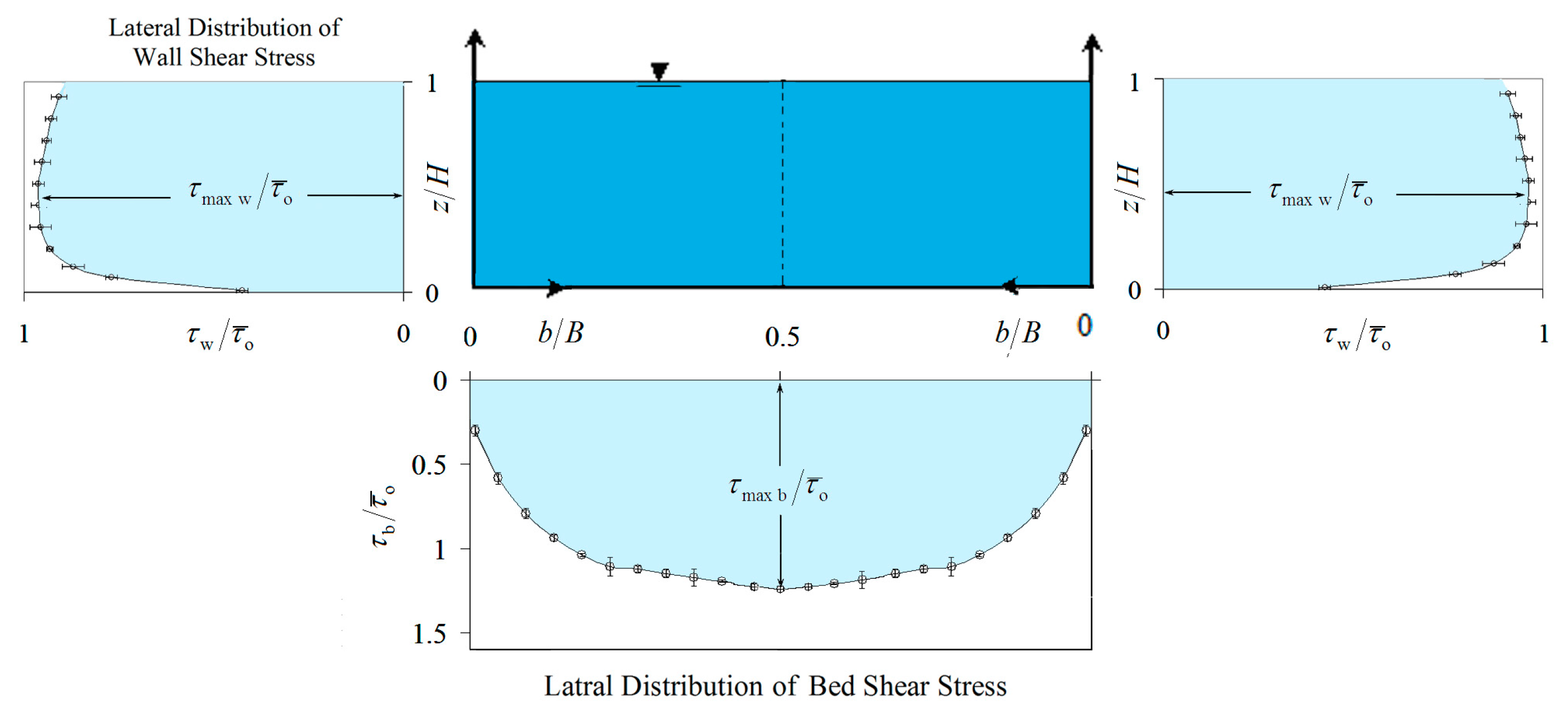
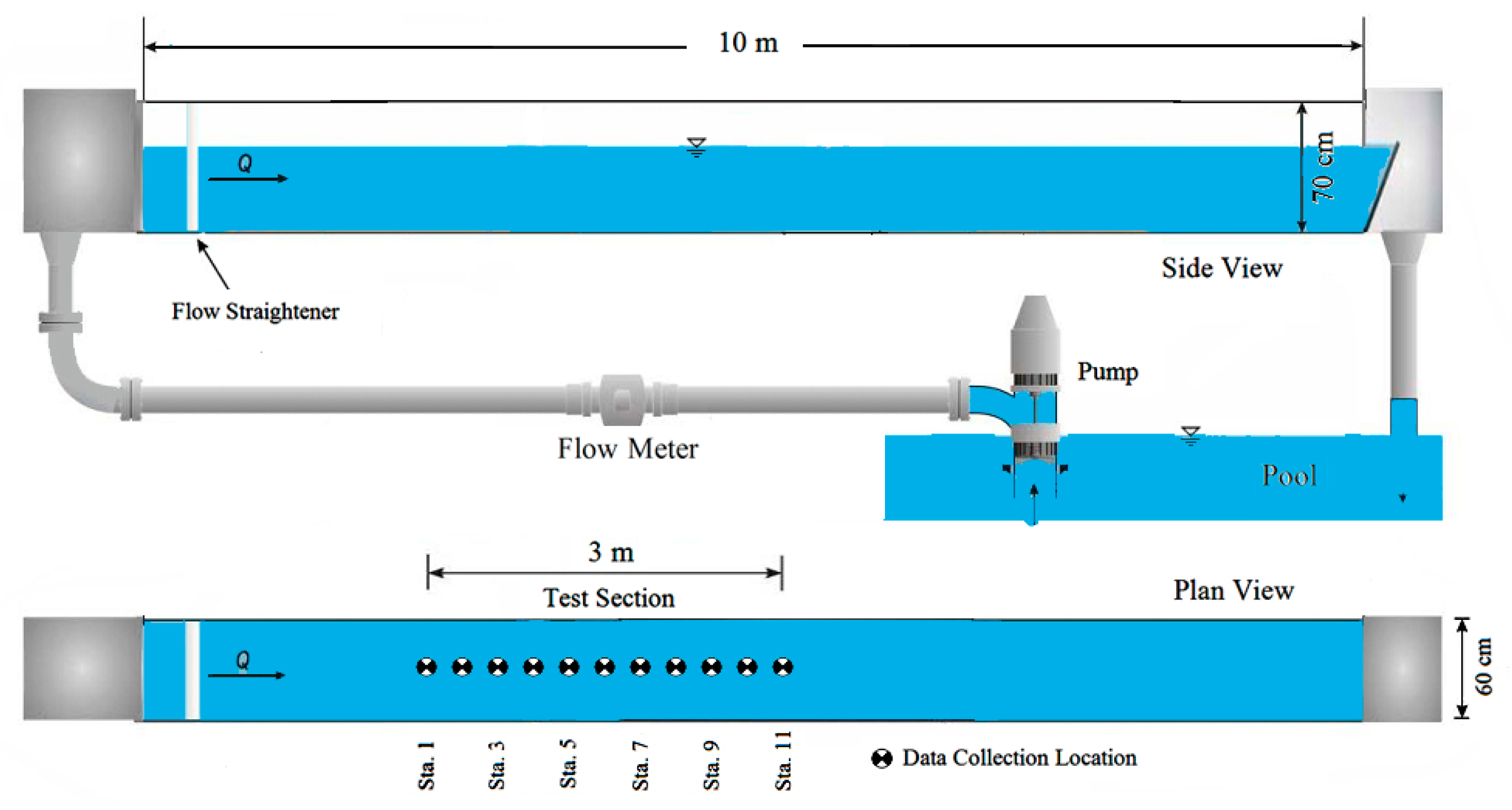

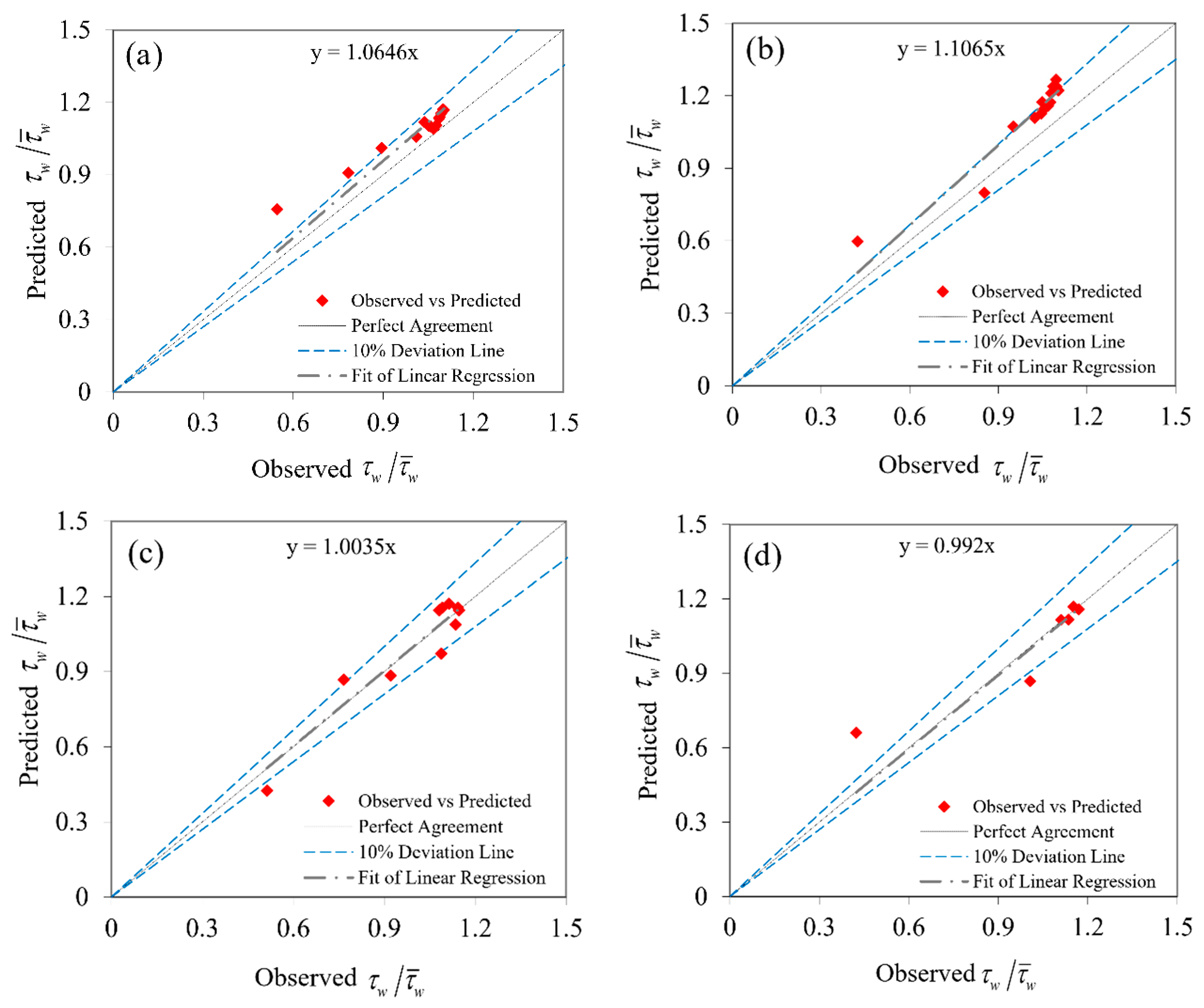
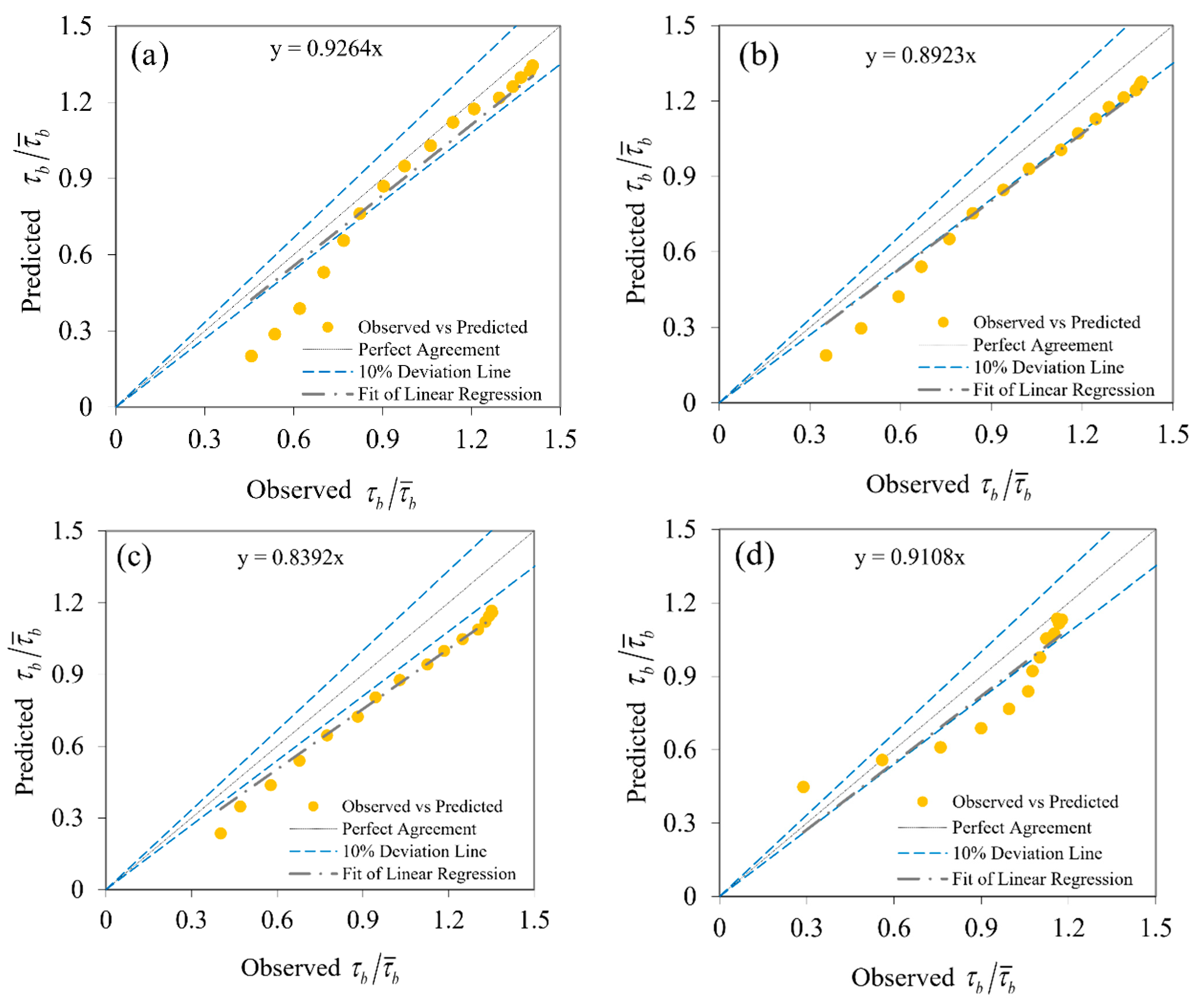
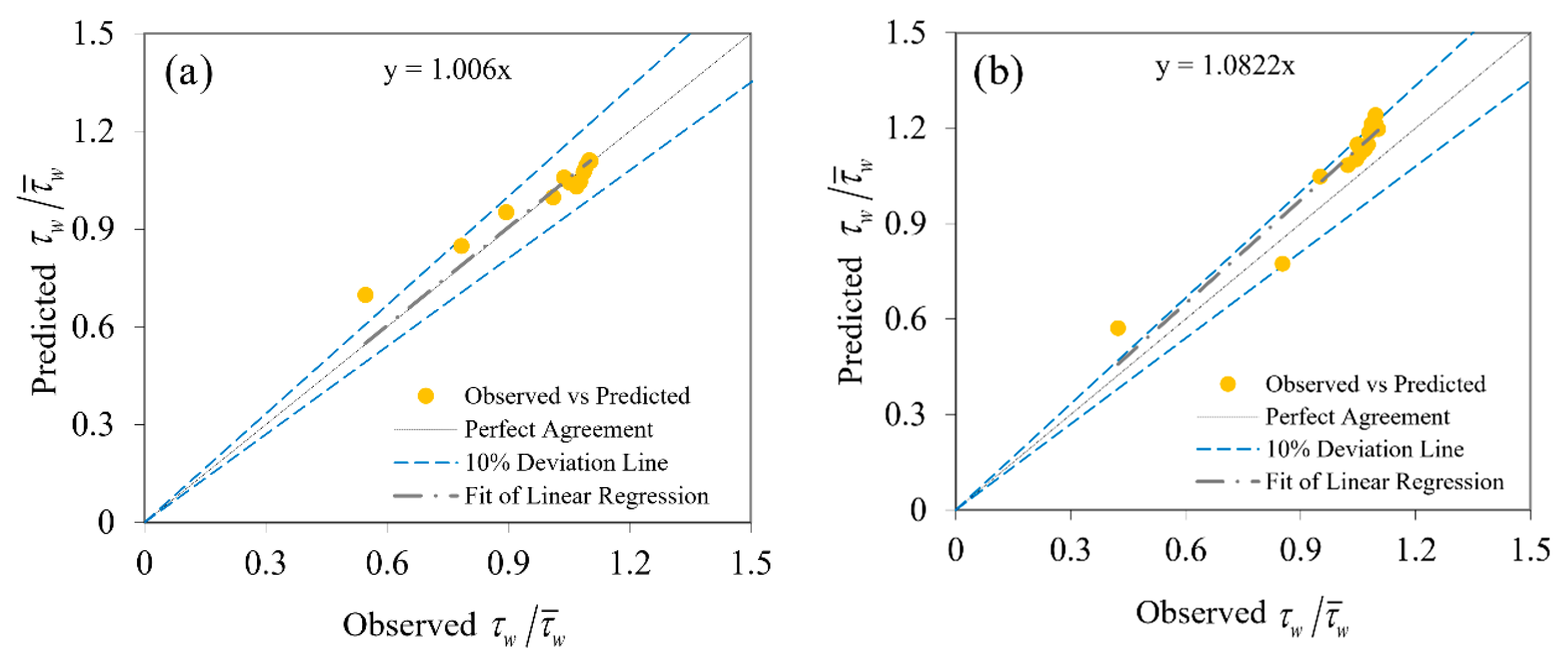

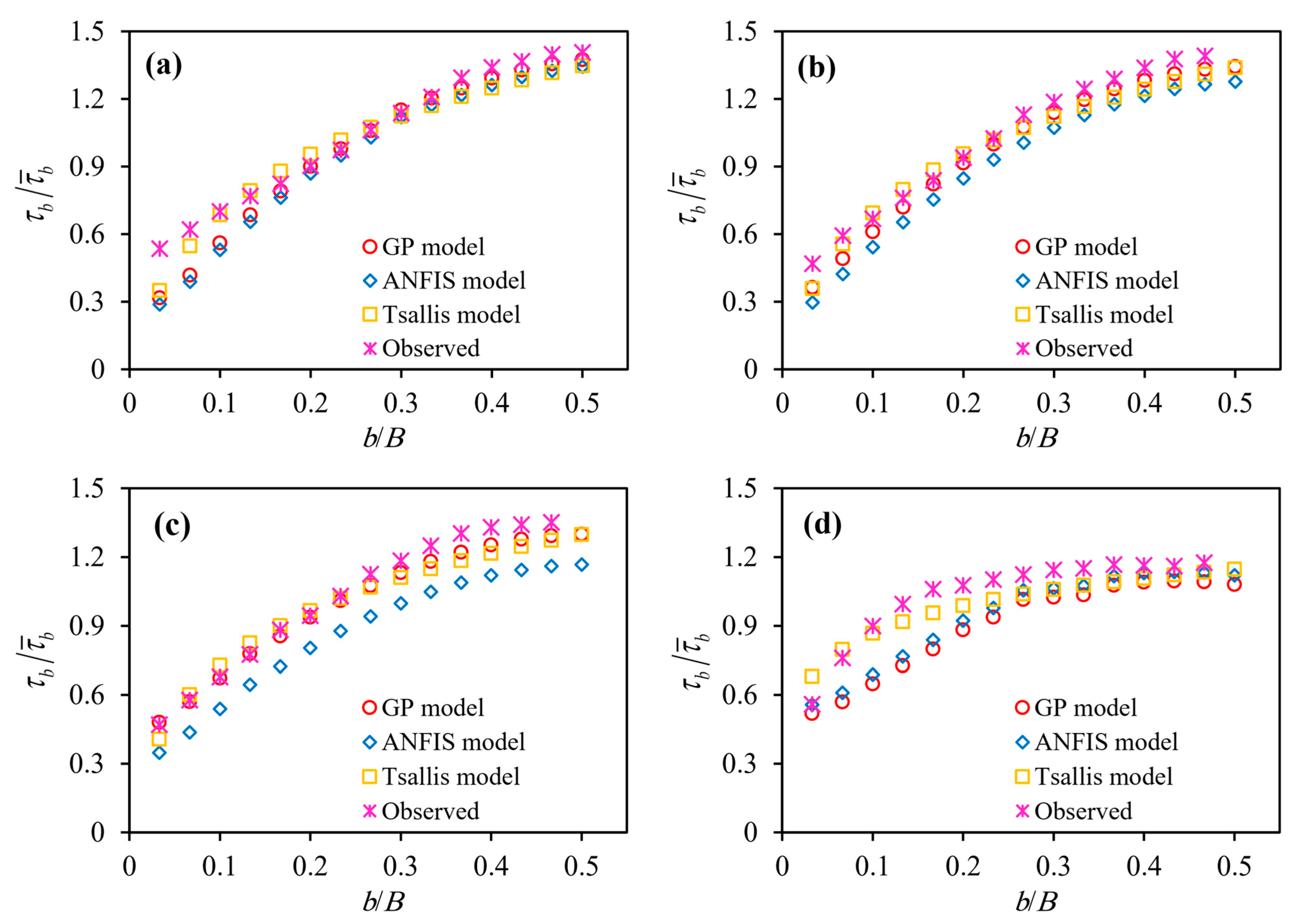
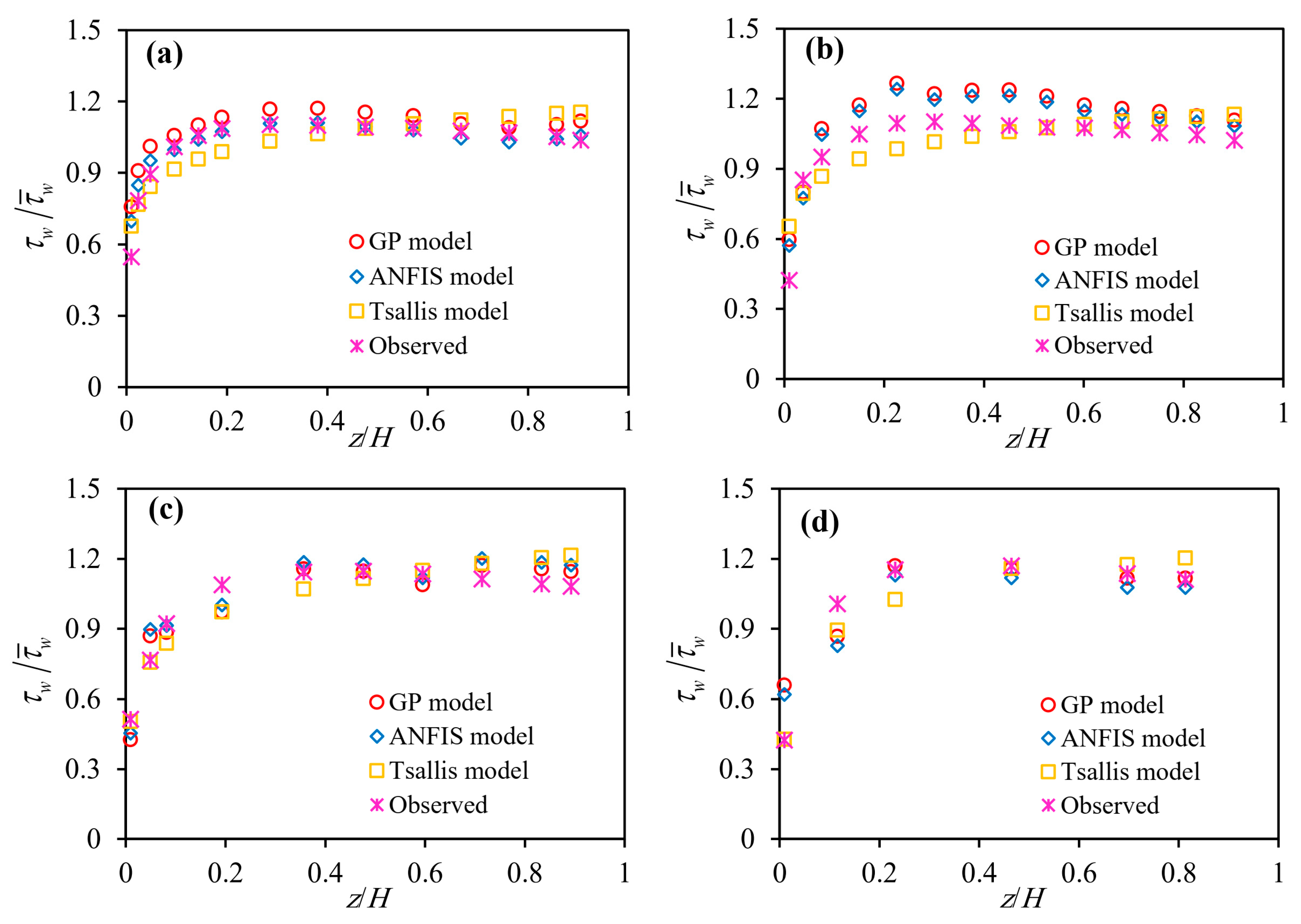
| Parameters | Variable Definition | Minimum | Maximum | Mean |
|---|---|---|---|---|
| H (m) | Flow depth | 0.043 | 0.21 | 0.0928 |
| B/H | aspect ration | 2.86 | 13.95 | 7.98 |
| Q (L/s) | Discharge | 11.06 | 102.38 | 34.795 |
| V (m/s) | Velocity | 0.429 | 0.813 | 0.568 |
| Fr | Froude number | 0.66 | 0.566 | 0.618 |
| Re | Reynolds number | 6.4 | 39.87 | 16.418 |
| Shear Reynolds | 0.322 | 0.609 | 0.426 | |
| γHS | Total shear stress | 0.442 | 2.162 | 0.955 |
| Parameter | Definition | Value (Model 1) | Value (Model 2) | Value (Model 3) |
|---|---|---|---|---|
| P1 | Function set | +, −, *, √, ^2, cos, sin, exp | +, −, *, √, ^2, cos, sin, exp | +, −, *, √, ^2, cos, sin, exp |
| P2-1 | The terminal set for | b/B, B/H, Fr, Re | b/B, B/H, Fr | b/B, B/H |
| P2-2 | The terminal set for | z/H, B/H, Fr, Re | z/H, B/H, Fr | z/H, B/H |
| B/H | Input Variable | Bed | Input Variable | Wall | ||||||
|---|---|---|---|---|---|---|---|---|---|---|
| ME | MAE | RMSE | NSE | ME | MAE | RMSE | NSE | |||
| 2.86 | b/B, B/H, Fr, Re | 0.2338 | 0.0837 | 0.1062 | 0.947 | z/H, B/H, Fr, Re | 0.0363 | 0.0617 | 0.0516 | 0.8021 |
| 2.86 | b/B, B/H, Fr | 0.2445 | 0.1038 | 0.1206 | 0.9456 | z/H, B/H, Fr | 0.0693 | 0.0257 | 0.0821 | 0.7759 |
| 2.86 | b/B, B/H | 0.2259 | 0.0713 | 0.1051 | 0.9382 | z/H, B/H | 0.0728 | 0.0217 | 0.0870 | 0.7277 |
| 4.51 | b/B, B/H, Fr, Re | 0.0927 | 0.0473 | 0.0526 | 0.9911 | z/H, B/H, Fr, Re | 0.0546 | 0.0202 | 0.0701 | 0.8548 |
| 4.51 | b/B, B/H, Fr | 0.1019 | 0.0642 | 0.0638 | 0.9903 | z/H, B/H, Fr | 0.0818 | 0.0302 | 0.0890 | 0.8972 |
| 4.51 | b/B, B/H | 0.1450 | 0.0962 | 0.0995 | 0.9889 | z/H, B/H | 0.0874 | 0.0530 | 0.0972 | 0.8987 |
| 7.14 | b/B, B/H, Fr, Re | 0.0889 | 0.0466 | 0.0533 | 0.9958 | z/H, B/H, Fr, Re | 0.0422 | 0.0424 | 0.0507 | 0.8982 |
| 7.14 | b/B, B/H, Fr | 0.0851 | 0.0408 | 0.0493 | 0.9962 | z/H, B/H, Fr | 0.0330 | 0.0321 | 0.0617 | 0.8566 |
| 7.14 | b/B, B/H | 0.0826 | 0.0348 | 0.0468 | 0.9955 | z/H, B/H | 0.0589 | 0.1153 | 0.0648 | 0.9049 |
| 13.95 | b/B, B/H, Fr, Re | 0.2005 | 0.1269 | 0.1376 | 0.8667 | z/H, B/H, Fr, Re | 0.0612 | 0.0720 | 0.1045 | 0.7916 |
| 13.95 | b/B, B/H, Fr | 0.2678 | 0.1398 | 0.1566 | 0.8511 | z/H, B/H, Fr | 0.0559 | 0.0264 | 0.1117 | 0.8097 |
| 13.95 | b/B, B/H | 0.1619 | 0.0908 | 0.1059 | 0.8534 | z/H, B/H | 0.0716 | 0.0926 | 0.1126 | 0.7758 |
| B/H | Bed | Wall | ||||||
|---|---|---|---|---|---|---|---|---|
| ME | MAE | RMSE | NSE | ME | MAE | RMSE | NSE | |
| 2.86 | 0.2559 | 0.0991 | 0.1268 | 0.9279 | 0.0383 | 0.0314 | 0.0492 | 0.8026 |
| 4.51 | 0.1728 | 0.1240 | 0.1266 | 0.9744 | 0.0870 | 0.0959 | 0.1004 | 0.9033 |
| 7.14 | 0.2157 | 0.1699 | 0.1724 | 0.9871 | 0.0868 | 0.0634 | 0.0745 | 0.907 |
| 13.95 | 0.2278 | 0.1048 | 0.1271 | 0.8482 | 0.1792 | 0.0909 | 0.1145 | 0.7752 |
| B/H | Bed | Wall | ||||||
|---|---|---|---|---|---|---|---|---|
| ME | MAE | RMSE | NSE | ME | MAE | RMSE | NSE | |
| 2.86 | 1.252 | 0.0531 | 0.0706 | 0.9276 | 1.3145 | 0.0622 | 0.0797 | 0.7721 |
| 4.51 | 1.476 | 0.0522 | 0.0625 | 0.9425 | 1.3741 | 0.0749 | 0.0894 | 0.7632 |
| 7.14 | 1.538 | 0.0672 | 0.0685 | 0.9310 | 1.6254 | 0.0631 | 0.0738 | 0.8275 |
| 13.95 | 1.511 | 0.0643 | 0.0840 | 0.8426 | 1.2562 | 0.0893 | 0.1094 | 0.8398 |
Publisher’s Note: MDPI stays neutral with regard to jurisdictional claims in published maps and institutional affiliations. |
© 2021 by the authors. Licensee MDPI, Basel, Switzerland. This article is an open access article distributed under the terms and conditions of the Creative Commons Attribution (CC BY) license (http://creativecommons.org/licenses/by/4.0/).
Share and Cite
Lashkar-Ara, B.; Kalantari, N.; Sheikh Khozani, Z.; Mosavi, A. Assessing Machine Learning versus a Mathematical Model to Estimate the Transverse Shear Stress Distribution in a Rectangular Channel. Mathematics 2021, 9, 596. https://doi.org/10.3390/math9060596
Lashkar-Ara B, Kalantari N, Sheikh Khozani Z, Mosavi A. Assessing Machine Learning versus a Mathematical Model to Estimate the Transverse Shear Stress Distribution in a Rectangular Channel. Mathematics. 2021; 9(6):596. https://doi.org/10.3390/math9060596
Chicago/Turabian StyleLashkar-Ara, Babak, Niloofar Kalantari, Zohreh Sheikh Khozani, and Amir Mosavi. 2021. "Assessing Machine Learning versus a Mathematical Model to Estimate the Transverse Shear Stress Distribution in a Rectangular Channel" Mathematics 9, no. 6: 596. https://doi.org/10.3390/math9060596
APA StyleLashkar-Ara, B., Kalantari, N., Sheikh Khozani, Z., & Mosavi, A. (2021). Assessing Machine Learning versus a Mathematical Model to Estimate the Transverse Shear Stress Distribution in a Rectangular Channel. Mathematics, 9(6), 596. https://doi.org/10.3390/math9060596






